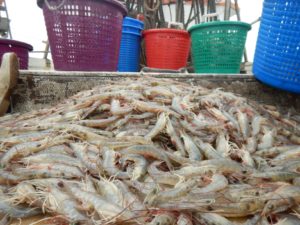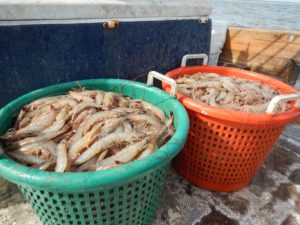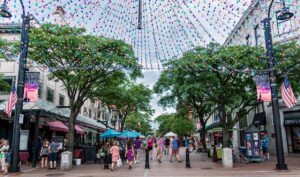
Many boats go in and out daily, as the shrimping grounds lie between one to eight miles offshore, but it’s common for some to stay out several days if the catch is good. Like Reaves and Lang, commercial fishing in this region is synonymous with multi-generation small-scale operators harvesting shrimp, as well as other seafood such as blue crabs, oysters and finfish. In the Lowcountry, life’s all about shrimp and seafood, heritage and culture, career and cuisine.
“Parts of Georgia are called the Lowcountry, which I’d say refers to the low elevation of the landscape on the coast. We’ve got salt marshes, estuaries and rivers in abundance that support a wide diversity of marine life,” says Angela Wigger, director of tourism for the St. Marys Convention & Visitors Bureau in St. Marys, GA. “Note, the term ‘Low Country,’ two words, is considered a recognized region of South Carolina, and some tie, at least the Savannah area in with that, but our designated region by the state of Georgia is the Georgia Coast.”
Shrimping flourished along the coast of these two southern states for most of the 20th century. Nowadays, the industry is a fraction of what it was even 30 years ago, according to Bryan Fluech, associate director at the University of Georgia’s Marine Extension and Georgia Sea Grant program in Brunswick. “One major factor contributing to the downsizing of our fleet has been the growth and dependence of imported shrimp. Shrimp is the number one seafood commodity eaten in the United States, but less than 10% of the shrimp we eat is caught domestically. That said, shrimp is still Georgia’s number one commercial fishery, and the shrimp our local crews help bring to our tables is also one of many reasons why people come to the Georgia coast.”
Shrimp are called an “annual crop,” because their life span ranges from eight to 12 months, thus a new generation of shrimp hatches every year.
“There’s three seasons when it comes to commercial shrimping,” explains Lang, who with his family also operates Lang’s Restaurant & Retail Fish Market and Lang’s Marina, where both shrimp boats and visiting yachts dock. “The first is roe shrimp, which are white shrimp that have just spawned, and that’s a short season that starts in May. Then, the brown shrimp season is from June to August. The brownies taste fine, but they’re usually small, and what people are looking for is the big plump white shrimp. The white shrimp season starts in August and runs through January, with the peak in September and October.”
Lang’s father pioneered the rock shrimp industry in the 1970s, put in a peeling plant, and by the 1980s St. Marys was known as the Rock Shrimp Capital of the East Coast.
Known for their rock-hard shells and sweet meat, rock shrimp are deep-water species unrelated to the brown and white varieties. The species totals less than 1% of the Lowcountry shrimp harvest, yet the annual St. Marys Rock Shrimp Festival is a big deal and going strong.
These days, Reaves — who started shrimping at age 14, ran his own boat by 16 and readily admits he has saltwater flowing through his veins — is spending more time onshore than off. Specifically, he and his family run the Sea Eagle Market, which sells the fresh catch from the family’s three shrimp trawlers and five oyster boats, retail, wholesale and
to local restaurants.

“The seafood on our menu is sourced locally from purveyors like Sea Eagle Market and the Bluffton Oyster Co.,” says Chef Brandon Carter at FARM Bluffton on May River Road in Bluffton, SC, who last year was one of four chefs in the state named a South Carolina Chef Ambassador. “A signature dish that stays on the menu in some variation is the May River Blue Crab & Shrimp Rice.”
Shrimp and grits is a Lowcountry staple, and Chef William Shaffer serves this southern tradition with a trendy twist at his 401 West Restaurant in St. Marys, GA. Specifically the dish is finished with a bourbon bacon butter sauce, the bacon is made in-house using a 13-day smoke and cure process, and the grits are stone ground. These ingredients sound lip-smacking on their own, but when they come together, their roles support the key ingredient — fresh-caught Lowcountry coastal shrimp.
“Good food is a universal language, and the Lowcountry speaks that language very well,” says Shaffer.
Lowcountry Shrimp & Seafood Festivals
Sample the region’s world-famous fresh catch at these lively annual events.
McClellanville, SC, May 2
Bluffton, SC, July 9-10
Beaufort, SC, October 2-3
Little River, SC, October 10-11
Jekyll Island, GA, November 6-8





